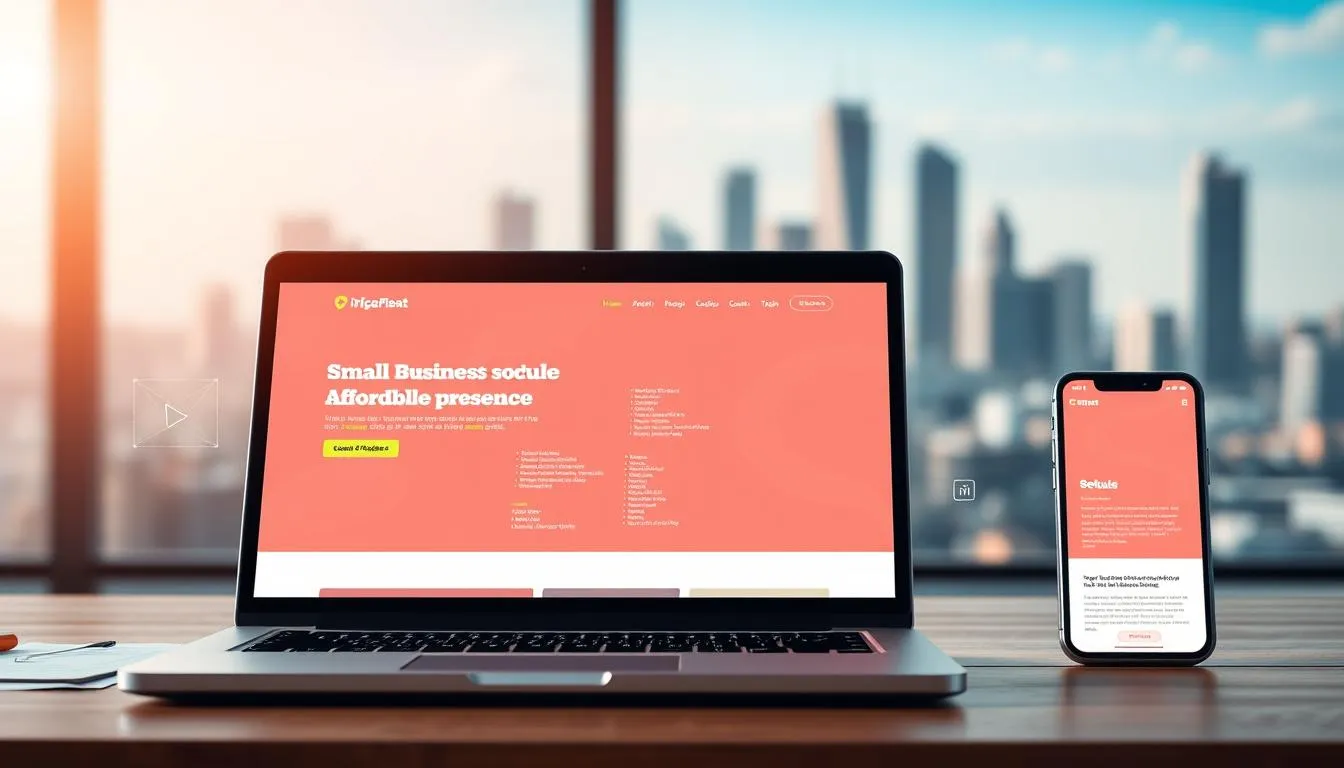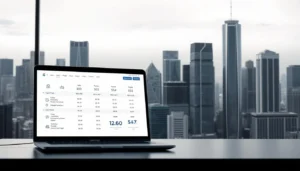Last Updated on: June 19, 2025
In today’s digital landscape, having a professional website is crucial for small business success. A well-designed website not only enhances your online presence but also plays a significant role in attracting new customers and driving sales. As a small business owner, you’re likely aware of the importance of having a website that effectively represents your brand.
However, many small businesses struggle to find a web design solution that fits their budget. The good news is that affordable web design options are available, allowing you to create a stunning website without breaking the bank. In this article, we’ll explore the world of affordable web design and provide insights into the costs associated with creating a small business website.
Key Takeaways
- Understanding the importance of a professional website for small business success
- Exploring affordable web design options for small businesses
- Breaking down the costs associated with creating a small business website
- Discovering the benefits of investing in a well-designed website
- Learning how to create a stunning website on a budget
The Critical Role of Websites for Small Businesses Today
The digital age has made it imperative for small businesses to establish an online presence. In today’s competitive market, having a professional website is no longer a luxury, but a necessity for businesses looking to expand their reach and build credibility.
Why Every Small Business Needs an Online Presence
An online presence allows small businesses to reach a wider audience, beyond geographical limitations. It provides potential customers with easily accessible information about products and services, enhancing customer engagement and potentially increasing sales. A website acts as a 24/7 marketing tool, working for the business even when the owners are not actively working.
How a Professional Website Impacts Customer Trust and Credibility
A professionally designed website significantly impacts how customers perceive a business. It conveys a sense of professionalism and reliability, which are crucial for building customer trust. A well-designed website can make a small business appear larger and more established, leveling the playing field with bigger competitors.
The ROI of Quality Web Design for Small Businesses
Investing in quality web design yields a significant return on investment (ROI) for small businesses. By enhancing the online presence and credibility of a business, quality web design can lead to increased customer engagement, higher conversion rates, and ultimately, more sales. It’s an investment that pays off by driving business growth and expanding the customer base.
Understanding the True Cost of Web Design
Understanding the true cost of web design is crucial for small businesses looking to establish an online presence. The expenses associated with creating and maintaining a website can be significant, and it’s essential to break down these costs to make informed decisions.
Average Website Costs for Small Businesses in 2023
The average cost of a website for small businesses in 2023 can range from $2,000 to $10,000 or more, depending on the complexity of the design, the number of pages, and the features required. Basic websites with a few pages can start at around $2,000, while e-commerce sites or those requiring custom functionalities can cost significantly more.
Breaking Down Website Expenses: Design, Development, and Maintenance
Website expenses can be broadly categorized into design, development, and maintenance. Design costs include the visual aspects and user experience, while development involves turning the design into a functional website. Maintenance costs cover updates, security, and performance monitoring.
Hidden Costs to Watch Out For
Beyond the initial design and development costs, there are several hidden costs that small businesses should be aware of. These include:
- Domain registration and renewal fees
- Hosting costs, which can vary based on the type of hosting (shared, VPS, dedicated)
- Ongoing maintenance expenses to keep the website secure and updated
Domain and Hosting Fees
Domain registration can cost between $10 to $35 per year, while hosting costs can range from $5 to $50 per month, depending on the hosting type and provider.
Ongoing Maintenance Expenses
Regular maintenance is crucial for website security and performance. Costs can vary widely, from $50 to $500 per month, depending on the frequency of updates and the complexity of the website.
Where Can Small Businesses Find Affordable Web Design?
Affordable web design is within reach for small businesses willing to explore their options. In today’s competitive digital landscape, having a professional website is crucial for attracting customers and establishing credibility.
Local Web Design Agencies Specializing in Small Business Solutions
Local web design agencies offer tailored solutions that cater to the specific needs of small businesses. They provide personalized service and can offer insights into local market trends. By choosing a local agency, businesses can also benefit from face-to-face meetings and a more personalized approach to their web design needs.
Freelance Designers vs. Design Agencies: Cost Comparison
Freelance designers and design agencies both have their advantages. Freelancers typically charge lower rates and can offer a more direct line of communication. Design agencies, on the other hand, bring a team of experts to the table, potentially offering a broader range of skills and more comprehensive services. The choice between the two often comes down to the specific needs and budget of the business.
Online Platforms Connecting Businesses with Affordable Designers
Online platforms have revolutionized the way businesses find web design services. Platforms like Upwork and Fiverr connect businesses with a global pool of talented designers, offering a range of services at competitive prices.
Upwork and Fiverr: Finding Quality Designers
Upwork and Fiverr are popular choices for businesses looking for affordable web design. These platforms allow businesses to post their project requirements and receive bids from qualified designers. They also provide reviews and ratings to help businesses make informed decisions.
Design Contests and Crowdsourcing Options
Design contests and crowdsourcing represent another avenue for businesses. By hosting a design contest, businesses can receive multiple design concepts and choose the one that best fits their vision. This approach can be cost-effective and provides a range of creative options.
As emphasized by
“The key to successful web design is not just about aesthetics; it’s about creating a user-friendly experience that drives conversions.”
Exploring these options can help small businesses find the perfect balance between affordability and quality.
DIY Website Builders: A Budget-Friendly Option
For small businesses on a tight budget, DIY website builders offer an attractive solution. These platforms provide an array of templates, drag-and-drop tools, and user-friendly interfaces that make creating a website easier than ever.
Top Website Builders for Small Business Owners
Several DIY website builders stand out for their features, pricing, and suitability for small businesses. Let’s take a closer look at some of the top options.
Wix: Features and Pricing for Small Businesses
Wix is a popular choice among small business owners due to its extensive template library and intuitive editor. Pricing plans range from $14 to $39 per month, making it an affordable option.
- Drag-and-drop editor for easy customization
- Hundreds of templates to choose from
- Integrated SEO tools
Squarespace: Design-Forward Solutions
Squarespace is known for its sleek, modern templates that appeal to businesses looking for a design-forward approach. Pricing starts at $14 per month, with e-commerce plans available.
- High-quality, responsive templates
- Built-in e-commerce functionality
- 24/7 customer support
Shopify: E-commerce Made Simple
Shopify is a leading e-commerce platform that offers a range of plans starting at $29 per month. It’s ideal for businesses looking to sell online.
- Comprehensive e-commerce tools
- Secure payment processing
- Inventory management
Pros and Cons of Using DIY Website Platforms
While DIY website builders offer many benefits, there are also some drawbacks to consider.
Real Cost Analysis: DIY vs. Professional Design
When deciding between a DIY website builder and hiring a professional designer, cost is a significant factor. Here’s a breakdown of the costs involved.
WordPress: The Affordable and Scalable Solution
For small businesses looking for an affordable and scalable web solution, WordPress stands out as a top choice. With its open-source nature and vast community support, WordPress offers a flexible and cost-effective way to establish an online presence.
Why WordPress Dominates the Small Business Market
WordPress has become the go-to platform for many small businesses due to its ease of use, customizability, and scalability. Whether you’re a local bakery or a tech startup, WordPress can be tailored to fit your business needs.
One of the key reasons WordPress is so popular is its vast array of themes and plugins. With thousands of options available, you can easily find a theme that matches your brand and plugins that add the functionality you need.
Getting Started with WordPress on a Budget
Starting with WordPress can be as budget-friendly as you need it to be. Here are some initial steps to get you started:
- Choose a reliable hosting service that offers WordPress-specific plans.
- Select a free or premium theme that aligns with your brand.
- Install essential plugins for SEO, security, and performance.
Premium Themes and Plugins Worth the Investment
While WordPress offers many free resources, investing in premium themes and plugins can elevate your website’s functionality and design. Premium themes often come with dedicated support and more advanced features.
Some premium plugins worth considering include:
Essential WordPress Plugins for Small Businesses
By leveraging these tools, small businesses can create a robust online presence that is both affordable and scalable.
E-commerce Solutions That Won’t Break the Bank
Setting up an online store doesn’t have to be expensive; there are several budget-friendly e-commerce platforms to choose from. Small retailers can now establish a robust online presence without breaking the bank.
Affordable E-commerce Platforms for Small Retailers
Several e-commerce platforms cater specifically to small businesses, offering affordable solutions. Shopify and WooCommerce are popular choices, providing a range of customizable themes and user-friendly interfaces.
- Shopify: Offers a comprehensive e-commerce solution with various pricing plans, starting at $29 per month.
- WooCommerce: A WordPress plugin that turns your website into a fully functional online store, with costs depending on hosting and additional features.
Setting Up an Online Store on a Limited Budget
To set up an online store on a budget, consider the following steps:
- Choose an affordable e-commerce platform.
- Select a pre-designed theme that aligns with your brand.
- Optimize product listings with high-quality images and detailed descriptions.
Payment Processing Options and Their Costs
Payment processing is a critical aspect of any e-commerce solution. Popular payment gateways include PayPal, Stripe, and Square. Each has its fee structure:
- PayPal: Charges 2.9% + $0.30 per transaction.
- Stripe: Also charges 2.9% + $0.30 per transaction, with variations based on the business type.
Transaction Fees Comparison
By understanding these costs, small retailers can make informed decisions about their e-commerce solutions and payment processing options.
Strategies to Reduce Web Design Costs Without Sacrificing Quality
Reducing web design costs without sacrificing quality is a top priority for small businesses looking to establish a strong online presence. By employing several strategic approaches, businesses can achieve a high-quality website on a budget.
Preparing Your Content and Brand Assets in Advance
One effective way to reduce web design costs is by preparing your content and brand assets in advance. Having all necessary materials ready allows designers to work more efficiently, reducing the overall design time and costs. This includes having your logo, brand colors, and content (text and images) prepared and organized.
Phased Website Development Approach
Adopting a phased development approach is another strategy to manage costs. By launching a basic version of your website first and then adding more features and functionalities in subsequent phases, you can spread out the costs over time. This approach not only helps in budgeting but also allows for testing and refinement based on user feedback.
Negotiating with Designers and Developers
Negotiating with designers and developers can also lead to cost savings. Understanding the scope of work and being clear about your budget can help in reaching a mutually beneficial agreement. It’s also beneficial to get quotes from multiple providers to compare prices and services.
Template Customization vs. Custom Design
Choosing between template customization and custom design is a critical decision that affects both cost and quality. While custom design offers uniqueness, template customization can be a cost-effective way to achieve a professional-looking website. By selecting a suitable template and customizing it to fit your brand, you can save on design costs without compromising on the overall look and feel.
By implementing these strategies, small businesses can effectively reduce web design costs while ensuring their website meets their business needs and quality standards.
Essential Features Every Small Business Website Needs
In today’s digital landscape, having a website with the right features is crucial for small businesses to establish a strong online presence. A well-crafted website not only attracts potential customers but also retains them by providing a seamless user experience.
Mobile Responsiveness and Why It’s Non-Negotiable
With the majority of internet users accessing websites through mobile devices, mobile responsiveness is no longer a luxury, but a necessity. A mobile-responsive website adapts to different screen sizes, ensuring that your content is easily accessible to all users.
SEO Fundamentals for Better Visibility
Search Engine Optimization (SEO) is critical for improving your website’s visibility on search engines. By incorporating SEO fundamentals such as keyword research, meta tags, and quality content, you can significantly enhance your website’s ranking.
Contact Forms and Call-to-Actions That Convert
Effective contact forms and call-to-actions (CTAs) are vital for converting visitors into customers. They guide users through your website, encouraging them to take the desired action.
Loading Speed and Performance Considerations
A website’s loading speed significantly impacts user experience and search engine rankings. Optimizing images, leveraging browser caching, and minimizing HTTP requests can improve your website’s performance.
Success Stories: Small Businesses with Effective, Affordable Websites
Small businesses are increasingly finding success with websites that are both budget-friendly and highly effective. In today’s digital age, having a professional online presence is crucial for attracting and retaining customers.
The following case studies highlight how two small businesses transformed their online presence with affordable web design solutions.
Local Retail Store’s Website Transformation
A local retail store in California was struggling to compete with larger online retailers. By investing in a responsive website design, they were able to increase their online sales by 30% within the first six months.
The new website not only improved their online visibility but also enhanced the overall customer experience, leading to a significant increase in customer loyalty.
Service Business Website on a Shoestring Budget
A service-based business in New York managed to create a highly effective website on a limited budget. By utilizing WordPress and selecting a premium theme, they were able to launch a professional-looking site without breaking the bank.
Their website has since become a key tool for attracting new clients and showcasing their services.
Lessons Learned from Successful Small Business Websites
These success stories highlight the importance of investing in a well-designed website, even on a limited budget. Key takeaways include the need for mobile responsiveness, easy navigation, and clear calls-to-action.
By prioritizing these elements, small businesses can create effective websites that drive real results.
Conclusion: Balancing Cost and Quality for Long-Term Success
Creating an effective website for your small business requires a delicate balance between cost and quality. As discussed, investing in a professional website is crucial for establishing credibility, attracting customers, and driving long-term success.
By understanding the true cost of web design, exploring affordable options like DIY website builders and WordPress, and prioritizing essential features, small businesses can achieve a high-quality online presence without breaking the bank.
The key to long-term success lies in balancing cost and quality. This means being mindful of expenses while investing in elements that matter most, such as mobile responsiveness, SEO, and user experience. By doing so, small businesses can reap the benefits of a well-designed website, from increased customer trust to improved conversion rates.
Ultimately, a well-designed website is a valuable asset that can drive business growth and help small businesses thrive in a competitive online landscape.
FAQ
What is the average cost of a website for a small business?
The average cost of a website for a small business can vary widely, depending on the complexity of the design, the number of pages, and the features required. On average, a basic website can cost between $2,000 to $10,000.
How long does it take to design a website for a small business?
The time it takes to design a website for a small business can range from a few weeks to several months, depending on the scope of the project and the availability of content and feedback from the business owner.
What are the essential features that every small business website needs?
Every small business website needs to be mobile-responsive, have a clear and concise navigation menu, include a contact form and call-to-action, and be optimized for search engines (SEO). Additionally, a fast loading speed and secure payment processing are crucial for e-commerce websites.
Can I use a DIY website builder like Wix or Squarespace?
Yes, DIY website builders like Wix, Squarespace, and Shopify can be a cost-effective and user-friendly option for small businesses. However, they may have limitations in terms of customization and scalability.
What is the difference between a custom-designed website and a template-based website?
A custom-designed website is tailored to the specific needs and branding of a business, while a template-based website uses a pre-designed template that can be customized to some extent. Custom-designed websites offer more flexibility and uniqueness, but are generally more expensive.
How often should I update my website?
It’s recommended to update your website regularly to keep the content fresh, improve search engine rankings, and ensure that the design and features remain modern and secure. The frequency of updates depends on the type of business and the purpose of the website.
What is the importance of SEO for my website?
SEO (Search Engine Optimization) is crucial for improving the visibility and ranking of your website in search engine results pages (SERPs). This can drive more traffic to your website, increase brand awareness, and ultimately lead to more conversions and sales.
Can I manage my website myself, or do I need to hire a professional?
While some small business owners may have the technical expertise to manage their website themselves, many others may prefer to hire a professional web designer or developer to handle the design, development, and maintenance of their website.
What are the costs associated with maintaining a website?
The costs associated with maintaining a website include domain registration, web hosting, content updates, security measures, and potentially, ongoing maintenance and support services from a web developer or agency.
How can I ensure that my website is secure?
To ensure that your website is secure, you should implement proper security measures such as HTTPS encryption, regular software updates, strong passwords, and backups. You should also be cautious when installing third-party plugins or themes, and monitor your website regularly for potential security threats.




